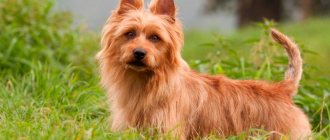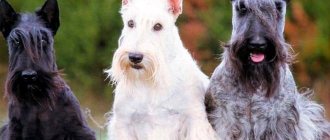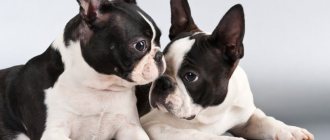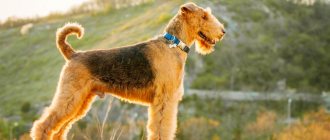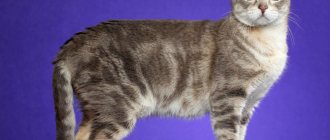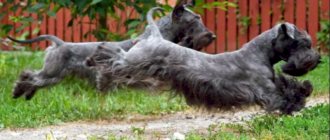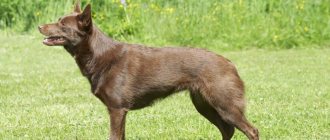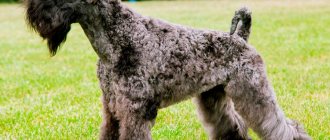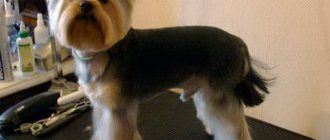The Silky Terrier is a brave, confident and inquisitive dog, always ready for action. Here is a dog that is a terrier through and through, with all these charming traits: smart, but stubborn and mischievous, and yet very loyal. They make excellent companions and excellent family dogs. Their loyalty to their owners, combined with their small size and lack of shedding, makes them an ideal choice for those who live in apartments or urban environments.
They are alert and ready to bark at any event in their environment. Always ready for a walk or romp in the yard, these dogs are an ideal choice for active singles, couples, or families with older children. The breed is called the Silky Terrier in North America, but is also called the Australian Silky Terrier in its country of origin and throughout the world.
They excel in a wide variety of dog sports, including obedience, agility, rallying, flyball, tracking and burrow trials.
Many believe that the Silky Terrier is a cross between the best of the Australian and Yorkshire Terriers, and are very similar, but they are still different.
Silky will always be the center of attention, friendly to strangers and hopes to win you over with all his charm. He is smart and sassy and has a way of teaching his owners to do whatever he wants. For this reason, a strong but gentle approach is required to compensate for its rather demanding nature.
These dogs are not for those who hate barking because snares can be very barking at times. Don't be fooled by the cute looks - he's still a terrier ready to dig, chase and play.
Snares are portable and suitable for those who plan to travel with their dog. Most will fit comfortably under an airplane seat or in a car seat during a trip. Because they are slightly larger than the Yorkshire Terrier, they are better suited for families with active children. However, no dog should be subjected to rough play without parental supervision.
Training is something that needs to start from the first days of this dog's life in your home. They need to be socialized around a wide variety of people and animals and, because they are intelligent, they need to be raised with a firm yet gentle approach.
Standards for this breed vary from country to country. In the US, tail docking is still part of the standard. In other parts of the world the tail is not docked.
Their long, silky soft coat requires a lot of effort to prevent tangles from forming. The snare has long hair, but it does not reach the ground. It's silky soft and comes in a single layer that requires brushing and brushing several times a week. A small amount of conditioner after washing will help loosen the tangles that form and make the combing process much easier.
Well-groomed snares are similar to Yorkshire terriers . You can do grooming yourself at home or take your dog to a groomer.
The Silky Terrier is a healthy breed with a lifespan of 12 to 15 years. Like humans, all small dogs have the potential to develop genetic problems, some of which can be reduced by genetic testing of the parent dogs.
Many of the problems associated with Silky Terriers are common in other breeds, so don't let this list scare you away from this breed.
Story
Several representatives of the terrier group participated in the formation of the Australian Silky Terrier breed. In the 18th century, English colonists moved to Australia en masse, and they brought the breed there. People did not particularly care about the purity of the lines, they simply adapted the dogs to local conditions if possible.
The responsibilities of the four-legged pets became hunting, protecting the property and livestock of farmers, and catching rodents and poisonous snakes.
At the end of the 19th century, Yorkies arrived in Sydney, and local residents crossed them with Australian terriers. It was from the first that the new breed inherited its beautiful long hair. Otherwise, the snares turned out to be a smaller copy of their Australian ancestors. But even with improved appearance, the dog was considered a working dog.
The first mixed litters were not identified as a separate species: some puppies looked like Yorkies, others like Australians, and others were different from both. Further crossbreeding was carried out within the new dog breed until a stable type was developed.
In 1906, a standard was developed (later it was updated several times), and in 1907 the first Silkie Terrier breed was presented at an exhibition in Australia (and in Great Britain only in 1930).
The dogs came to the USA after World War II, where they gained enormous popularity and recognition. Until 1955, the species was called the Sydney Silky Terrier, but the American Canine Association renamed the dog.
The Silkie Terrier breed was officially registered in the USA in 1959.
Despite its popularity and attractiveness, the Silkie is a rare and expensive breed.
Description of the Silky Terrier
The dog's build is strong and dense, its legs are short. The movements of the snare are light, free and energetic. The breed belongs to the group of toy terriers, the main purpose is to be a companion.
Size
The height of the terrier at the withers is from 23 to 26 cm (males are larger). The dog's weight is 3.5-4.5 kg.
Head
The snare's skull is wedge-shaped (the length of the upper part of the head is longer than the muzzle), and is of medium size. Slightly flattened on top, the distance between the dog’s wedge-shaped erect ears is small (but there is a fold-eared variety).
The terrier's eyes are almond-shaped, small, dark. The look is attentive, piercing. The edges of the eyelids and nose are black. The transition to the forehead is moderate. The teeth of the snare are in line and have a scissor bite.
Body type
The dog's neck is medium, the scruff is pronounced. The topline is level. The chest is wide and deep. The terrier's body is moderately low and elongated. The tail is docked. Major defects are considered to be a dog's back curvature and short body.
Limbs
Straight, strong, moderately muscular. The angles of articulation of the elbows and knees are pronounced. The breed's paws are small and compact, with the toes pointing forward. The pads are elastic and thick.
Color
Blue, blue, with thick tan. Too light colors in the breed are unacceptable. The color starts from the scruff of the neck and extends to the tip of the tail, down to the elbows and knees of the dog.
Wool
Long, flowing, parted in the middle of the back. The axial hair is not hard, there is a soft undercoat. The hair is smooth to the touch. Shorter on the limbs.
Grooming
The Silky Terrier requires regular bathing and brushing. Their coat is single-layered with no undercoat, giving it a luxurious, silky texture. The right coat is shiny, cool to the touch and reflects light from the sun. Silka's hair is very similar to human hair. Cleanliness is very important, as dirty hair breaks easily and grows poorly. To keep the coat and skin in good condition, snares should be washed and brushed weekly or at least every two weeks. Even if a Silky Terrier does not have the correct silky coat texture, choosing the right products and using them correctly can create the illusion of a proper coat.
When bathing your Silky Terrier, try to minimize further tangling. After dampening the coat, apply a moisturizing shampoo. Thorough shampooing will help create a healthy, strong and manageable coat. It is vital that you condition the wool to retain moisture in each individual strand of hair. Be sure to rinse the coat thoroughly. For the final rinse, it is recommended to cool the water slightly. Afterwards, pat the fur dry with a towel and squeeze out excess water. Always remove excess moisture with a downward motion to prevent the coat from tangling.
It is best to dry with a hairdryer, combing each strand from top to bottom. There should be no tangles on the wool. The coat should be light and airy, but hang straight and move freely with the dog. Lightly work around the entire contour of the dog, removing hairs that interfere with the dog's natural movement. The body should be cut to the contour of the body, including the tuck at the waist, so that the hair is slightly raised above the ground. Use clippers to remove hair from the front and back of the ear. Trim the edges with scissors until they are even. Use thinning scissors to trim the eyes so that they form an upward "V" between the corners of the eyes and the part between the ears. Then use thinning scissors to lightly trim your bangs and reveal your beautiful eyes. Remember that the tail should not look like a flag.
Character and appearance
Despite their activity and temperament, dogs have a stable psyche and balance. Silks are distinguished by their fearlessness and pugnacity.
Dogs quickly become attached to their owners and get along with children. It is not recommended to own this breed of dog for people who lead a sedentary lifestyle, as terriers require frequent walks and vigorous exercise.
Expert opinion
Anna Abramenko
An avid dog lover. Experience in veterinary medicine since 2009.
Ask a Question
Silks willingly make contact with people, but as guards they are vigilant and incorruptible. Australian dogs are unobtrusive, know how to spend time on their own, and do not suffer from boredom.
Children who are too young can cause stress for a dog; a terrier can even bite in self-defense. But snares are friendly to pets, including cats with whom they live under the same roof.
Silk puppies are born almost black, but with age (up to 1.5 years) their color changes to blue or light blue.
If you do not show firmness and perseverance towards the Australian Terrier in time, then it will become dominant in the family, and the owners will have to fulfill its whims.
Pregnancy and childbirth
During childbirth, the owner must be nearby to provide the necessary assistance to the pet
Pregnancy lasts on average 56–63 days, but puppies usually appear before 60 days. The dog during this period needs special care:
- With the onset of the second month, she begins to consume twice as much food. But food should be divided into 4-5 feedings per day.
- The female also needs to drink plenty of fluids, since her body spends a lot of fluid to produce amniotic fluid.
From the 5th month, limit your pet’s physical activity; sudden movements are contraindicated..
Pregnancy can be determined by characteristic changes in the dog’s appearance, as well as by palpation:
- in the fourth week you can feel hard lumps in her abdomen;
- then the female’s mammary glands enlarge, their pigmentation changes, they become lighter;
- the stomach increases in size.
After the 55th day of pregnancy, regularly measure your dog's body temperature. When the readings drop to 37°C, begin preparations for the birth of the puppies (they will appear within the next 24 hours). Build a special place for your pet. The best option is a cardboard box with a high side, inside of which you need to lay clean diapers. It is also advisable to place a heating lamp nearby or put a heating pad (it is placed in the place where the puppies will lie, so as not to harm the bitch after giving birth).
The onset of labor is indicated by the behavior of the female. With the onset of contractions, she becomes restless, tries to attract attention to herself, whines, scratches the floor, and refuses to eat. Take the dog to a prepared area.
Before expulsion of the fetus, the bitch develops a mucous, transparent, sticky discharge. This is a natural phenomenon that should not be feared. Then a puppy appears. During the normal course of labor, he comes out upside down, head first. Your actions are as follows:
- The baby needs to be freed from the membranes, the umbilical cord is cut and the cut is treated with a disinfectant.
- Then it should be wiped clean of mucus.
- If the puppy is not breathing, rub it with a terry towel (do not overdo it so as not to harm the baby).
- The intervals between the births of babies are 15–30 minutes. If the duration exceeds 2 hours, you must urgently seek veterinary help.
- After the birth of each puppy, the placenta should be released. Count them and compare them with the number of puppies. If at least one remains inside your pet, contact your veterinarian immediately.
Education and training
You need to start training with a terrier from 2 months. The first skills are litter box training, walking on a leash, knowing a nickname. During lessons, a kind attitude towards the dog and rewards for success have a special effect. Early socialization is necessary, as the snare has a timid and shy character.
Such individuals are easy to train, distinguished by intelligence and excellent memory. But terriers quickly get tired of the monotony and begin to be stubborn, so different exercises need to be alternated more often. From puppyhood, Australian dogs require an authoritative attitude, as they are somewhat capricious.
Sometimes a dog is unable to overcome its hunting instincts - it gets distracted by birds, cats, sniffs out tracks, digs holes. When meeting with relatives, the terrier tries to take a leading position.
A restless pet needs active games, walks, jogging, and training. Otherwise, if kept passively for a long time, the Australian Terrier will begin to wither and get sick. Improper care will also affect the dog’s psyche – timidity or increased aggression will appear.
Australian Silky Terriers love to bark. They do it loudly, piercingly and for a long time.
Who is this dog suitable for?
The breed is suitable for people leading an active lifestyle. Snares for those who respect walks in the fresh air. The Silky Terrier is an alternative breed for people who like Yorkies, Cairns or Scottish Terriers.
The Australian “baby” will give everyone a head start. Silky is ideal for keeping in a city apartment, as it practically does not shed. It doesn't take up much space.
But for homebodies, phlegmatic people or busy people, such a silky dog will be a burden; it is not suitable for elderly people either. There is no need to get one for those who do not have the money and time to care for the silky coat of a pet.
Care and maintenance
Snares are not particularly demanding, and they are not difficult to care for. The terrier's long coat needs to be brushed 2-3 times a week. She is trimmed every 2-3 months. Excess hair around the eyes and on the ears of the dog is cut off.
It is recommended to bathe your pet 2-3 times a year and select exclusively soft, hypoallergenic shampoos. The dog is clean, so regular brushing is sufficient.
Expert opinion
Anna Abramenko
An avid dog lover. Experience in veterinary medicine since 2009.
Ask a Question
Up to 3 months, meals are three times a day, as they grow older, their frequency is reduced to 2, but the volume increases. Routine is very important for the Australian Terrier. When purchasing a puppy, you should ask the breeder what the animal was fed. You need to change your dog's diet gradually. Its basis is cereals, vegetables, lean meat.
Proven store-bought food or homemade products are suitable as food (but you cannot mix them at one time).
Cleaning the terrier's ears – once a week.
Aussie teeth are not prone to tartar or plaque buildup, but they should be examined regularly.
In the cold season, it is advisable for the terrier to wear overalls for walks.
Expert opinion
Anna Abramenko
An avid dog lover. Experience in veterinary medicine since 2009.
Ask a Question
The dog cannot be kept on a chain or in an enclosure, only in a house (apartment).
Breed traits
Breed traits (on a 5-point scale)
| Australian Terrier | |||
| Activity | in the house | 3.5 | |
| on the street | 4.5 | ||
| Obedience | training | 4 | |
| strangers | 4 | ||
| Domination | in family | 1 | |
| over dogs | 2 | ||
| Defending your territory | from people | 2.5 | |
| from dogs | 3 | ||
| Sociability | in family | 5 | |
| with strangers | 4 | ||
| with dogs | 4.5 | ||
| Concentration | in family | 1 | |
| in front of strangers | 1 | ||
| with dogs | 1 | ||
| Aggressiveness | in family | 1 | |
| to strangers | 1.5 | ||
| to the dogs | 1 | ||
| to cats | 1 | ||
| Family behavior | calmness | 5 | |
| demand for affection | 3.5 | ||
| excitability | 3.5 | ||
| playfulness | 4 | ||
| excessive barking | 3.5 | ||
| behavioral breakdowns | 1.5 | ||
| Tolerance for children | up to 4 years | 5 | |
| over 4 years old | 5 | ||
| Institutional use | watchman | 5 | |
| bodyguard | 2 | ||
This breed is often compared to the following dog breeds: Australian Shepherd (Aussie), Border Terrier, Australian Cattle Dog (Blue Heeler), Norwich Terrier, Akita Inu.
The photo shows what Australian terriers look like:
Health
Among small dogs, the Silka has the highest performance and adaptability to the environment. The breed is also excellent in health, as it inherited good genetics from its ancestors.
Typical diseases for the terrier are diabetes, epilepsy, skin diseases, and thyroid problems. But they are rare in animals.
Expert opinion
Anna Abramenko
An avid dog lover. Experience in veterinary medicine since 2009.
Ask a Question
Taking care of your pet's health includes timely vaccinations, systematic examinations by a veterinarian, proper feeding and maintaining activity.
Health and main diseases of the Australian Terrier
The purebred Australian Silkie Terrier is genetically predisposed to allergic reactions and dermatitis, diabetes and problems with the musculoskeletal system. The dog is prone to diseases such as:
- dislocations of the knee joint;
- episyndromes;
- joint dysplasia;
- tracheal collapse;
- herniated discs of the spine;
- vision problems (corneal ulcer, cataracts, glaucoma);
- colds.
You will definitely have to vaccinate your dog on time and regularly treat it against fleas, ticks or worms. If the terrier is active and eats healthy foods, he can live up to the age of thirteen.
List of nicknames
It is better to choose a name for your pet that is sonorous, suitable for the temperament, but not long and easy to remember:
- Suitable nicknames for boys are:
- Archie, Charlie, Dick, Jack, Max;
- Sam, Barney, Bucks, Ace, Cujo, Flash, Hugh, Rocky, Leo, Mike;
- Nemo, Nick, Oscar, Umka, Twix, Hooch, Caesar, Elvis, Ian, Hulk.
- For girls:
- Gina, Bella, Maggie, Lady, Dina, Chelsea, Sophie;
- Astra, Alpha, Alice, Barbie, Gerda, Busya;
- Eva, Maya, Nyura, Puma, Ruby, Tuchka, Fiona, Coco;
- Ellie, Juno, Utah, Fanta.
You need to accustom your pet to its name as soon as it appears in the family.
Rules for choosing puppies
When buying a dog, you need to get to know the kids' parents. Ideally, these are active, healthy animals with good pedigrees and adequate behavior. It is desirable for Australian dogs to have championship titles, especially if the owner plans to participate in exhibitions with the pet.
The puppy itself should look reasonably well-fed, active, and non-aggressive. The baby's gaze should be clear. The fur is shiny and thick. It is important to match the external characteristics of the Australian Terrier breed.
The baby should not be taken away from the mother before 2 months.
How to choose a healthy puppy
It is advisable to buy a puppy over 3 months of age
First of all, choose a nursery with a good reputation. To do this, you can visit a specialized exhibition or study offers on Internet resources.
Be sure to determine the purpose for which you are purchasing a dog , since the cost of the pet depends on this. A pet-class puppy costs about $500, a breed-class puppy costs from $900 to $1,200, and the price for a show-class terrier ranges from $1,300 to $2,000.
Important! You should not buy a baby under 3 months old. It is at this age that you can determine which class the dog belongs to.
The puppies' coat does not have the color characteristic of this breed. Until the dog reaches 18 months, it remains black in color. To make sure that your baby has no health problems and has been vaccinated in a timely manner, check his documents. When purchasing a puppy, the breeder must give you a puppy card, recommendations regarding raising, and a veterinary passport with vaccination information. Also check out his pedigree.
Video: behavior and appearance of puppies
Cost and where to buy
You can buy a dog for 15-60 thousand rubles. (price depends on the nursery and region). The best representatives of the breed from eminent parents are often sold for $1,200-2,000.
When buying a puppy on the market or from unknown people, the future owner runs the risk of taking a non-purebred or sick animal. The best option would be to contact a well-known kennel or a breeder who professionally breeds Silky Terriers. The conditions for keeping dogs must meet all hygienic requirements.
Feed mode
Silky Terriers need to eat dry food twice a day. The optimal amount is about half a cup for an adult animal and a quarter or less for puppies.
The daily amount of food any dog needs depends on its metabolism, age, body type, size and activity level. Some animals need more food, some less. You will notice that if your dog is more active, he will ask for more. If she is a lazy couch potato and you put in less food, she will be fine with it. The quality of the feed also affects the portion size. If you use high quality food, you will need less of it.
Reviews
Olga: “We bought a girl, 2 months old, she lives with us for half a year. She immediately became a family favorite. I quickly got used to the tray. Fortunately, the terrier hardly misbehaves and doesn’t chew shoes. Barks not as often as we were afraid. Loves to be in company, in the center of attention. I made friends with the cat, they communicate without conflicts. Sometimes it gets a little tiring with the activity, but overall the impression is positive, we don’t regret one bit that we chose it.”
Artem: “We bought our daughter an Australian puppy two years ago. We were worried that there would be difficulties in caring for the terrier, but in vain. We bathe him sometimes, brush him often, there is no hair on the sofas or carpets. The dog treats guests calmly and is sociable. An absolutely problem-free dog, and my daughter is so happy.”
Anastasia: “Silky is a good and devoted friend, he will never let you get bored. But it takes a lot of time. The terrier knows how to have fun on his own, but more often he looks for company. Constantly asks to go outside. He behaves restlessly. So if you don’t like unnecessary fuss, then the dog is not for you.”
Photo and video review
Having become familiar with the description and standards of the Silky Terrier in theory, you can proceed to viewing the photo gallery and video review.
Feeding options
You can feed your Silky Terrier premium or holistic dry food. Dry food is properly balanced and provides the dog’s body with useful substances. If desired, Silky can be fed natural food.
| Can | It is forbidden |
| Beef, chicken breast, turkey | Pork, lard, fat, sausages |
| Sea fish (fillet) | River fish |
| Beef by-products | Bird bones |
| Beef bones and cartilage | Sweet, flour, salty, smoked |
| Carrots, zucchini, pumpkin, broccoli | Cabbage, legumes, potatoes |
| Buckwheat and rice | Semolina and other cereals |
With a natural diet, you will need to add vitamin supplements and fish oil to your diet. It is highly undesirable to alternate natural and dry food.
